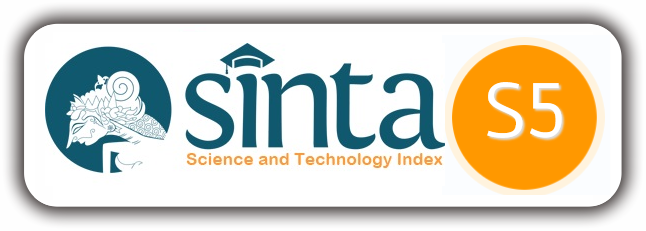STUDI UTANG PEMERINTAH REPUBLIK INDONESIA SEBAGAI PEMBIAYAAN ANGGARAN PENDAPATAN DAN BELANJA NEGARA (APBN) TAHUN 2000-2016
Yanuar Pribadi(1*)
(1) Maksi FEB UGM
(*) Corresponding Author
Abstract
Keywords
Full Text:
PDFReferences
Babbie, Earl R. 1990. Survey Research Methods, 2nd Edition. Belmont CA: Wadsworth Publishing Company.21Barro, Robert J. 1989. “The Ricardian Approach to Budget Deficits.” The Journal of Economic Perspectives Vol.3, No.2, (Spring, 1989). 37-54. American Economic Association.Creswell, John W. 2007. Qualitative Inquiry and Research Design : Choosing Among Five Approaches. 2nd Edition. California: SAGE Publications, Inc.—. 2014. Research Design : Qualitative, Quantitative and Mixed Methods Approaches, 4th Edition. California: SAGE Publication, Inc.Djamin, Zulkarnain. 1993. Pinjaman Luar Negeri serta Prosedur Administratif dalam Pembiayaan Proyek Pembangunan di Indonesia. Jakarta: UI Press.Direktorat Jenderal Anggaran. 2014. Dasar-dasar Praktek Penyusunan APBN di Indonesia, Edisi 2. Jakarta: DJA.Direktorat Jenderal Pengelolaan Pembiayaan dan Risiko. 2016. Laporan Tahunan Direktorat Jenderal Pengelolaan Pembiayaan dan Risiko Tahun 2015. Jakarta: DJPPR.—. 2017. Profil Utang dan Penjaminan Pemerintah Pusat : Bulan Januari 2017. Jakarta: DJPPR.Halim, Abdul, ed. 2016. Manajemen Keuangan Sektor Publik : Problematika Penerimaan dan Pengeluaran Pemerintah, Edisi 2. Jakarta: Salemba Empat.Harahap, Mahindun Diani Melia. 2007. “Analisis Faktor-Faktor yang Mempengaruhi Utang Luar Negeri Pemerintah.” Thesis. Medan: Universitas Sumatera Utara.Hennink, Monique, Inge Hutter, dan Ajay Bailey. 2011. Qualitative Research Methods, 1st Edition. California: SAGE Publications, Inc.Hyman, David N. 1999. Public Finance: A Contemporary Application of Theory and Policy, 6th Edition. Fort Worth: Dryden Press.Ibrahim. 2015. Metodologi Penelitian Kualitatif. Bandung: Alfabeta.Iheanacho, Eugene. 2016. “The Contribution of Government Expenditure on Economic Growth of Nigeria Disaggregated Approach.” International Journal of Economics & Management Sciences, Vol.5 : 369-376. doi: 10.4172/2162-6359.1000369.International Monetary Fund. 2014. External debt statistics : guide for compilers and users. Washington DC: IMF.International NGO Forum on Indonesian Development. 2017. Menuju Indonesia yang Lebih Setara. Jakarta: INFID.Islam, Md. Ezazul, dan Bishnu Pada Biswas. 2005. "Public Debt Management and Debt Sustainability in Bangladesh." Bangladesh Development Studies, Vol.31, No. 1/2, (March-June 2005): 79-102 . Bangladesh Institute of Development Studies. http://www.jstor.org/stable/40795703. Diakses pada 7 Oktober 2016.Islam, Muhammad. 2014. “Pengaruh Utang Pemerintah terhadap Pertumbuhan Ekonomi Indonesia.”22Thesis. Bogor: Institut Pertanian Bogor.Kabete, Conchesta Nestory. 2008. “Foreign Aid and Economic Growth: The Case of Tanzania.” Thesis. Hauge: Institute of Social Studies.Karacic, Domagoj, Bruno Dernaj, dan Mario Raic. 2015. “The Concept of Public Debt Management Strategy of The Republic Of Croatia.” Econoviews Vol.XXVIII No.2, 2015: 409-422.Kementerian Keuangan. 2006. Keputusan Menteri Keuangan Nomor 466/KMK.01/2006 tentang Organisasi dan Tata Kerja Kementerian Keuangan.—. 2012. Edukasi Keuangan : Kebijakan Pengelolaan Utang Negara. Jakarta: BPPK.—. 2014. Keputusan Menteri Keuangan Nomor 206/KMK.01/2014 tentang Organisasi dan Tata Kerja Kementerian Keuangan.—. 2015. Peraturan Menteri Keuangan Nomor 234/PMK.01/2015 tentang Organisasi dan Tata Kerja Kementerian Keuangan.Legatum. 2016. The Legatum Prosperity Index 2016, Tenth Edition. London: Legatum Institute.Mankiw, N. Gregory. 2013. Macroeconomics, 8th Edition. New York: Worth Publisher.Mansoer, Faried Wijaya. 2007. Makroekonomika Menengah dan Dasar, Edisi Pertama. Yogyakarta: BPFE-YOGYAKARTA.Melecky, Martin. 2012. "Formulation of Public Debt Management Strategies : An Empirical Study of Possible Drivers." Economic System 36 (2012): 218-234. Elsevier B.V. http://dx.doi.org/10.1016/j.ecosys.2011.08.001. Diakses pada 10 Oktober 2016.Miles, Matthew B., dan A. Michael Huberman. 1984. Qualitative Data Analysis: A Sourcebook of New Methods. California: SAGE Publications Inc.Nafziger, E. Wayne. 2006. Economic Development, 4th Edition. Cambridge: Cambridge University Press.Paientko, Tetiana. 2016. “Public Debt in Ukraine: Irrational Management And Risks Leading To Corruption.” Research Papers Of Wrocław University Of Economics, 2016: 265-274. DOI: 10.15611/pn.2016.439.23.Priyono, dan Teddy Chandra. 2016. Esensi Ekonomi Makro. Sidoarjo: Zifatama Publisher.Ramadhani, Muhammad Adib. 2014. “Pengaruh Defisit Anggaran, Pengeluaran Pemerintah dan Hutang Luar terhadap Pertumbuhan Ekonomi (Studi Kasus 6 Negara Asean Tahun 2003-2012).” Skripsi. Malang: Universitas Brawijaya.Republik Indonesia. 2002. Undang-Undang Nomor 24 Tahun 2002 tentang Surat Utang Negara.—. 2003. Peraturan Pemerintah Nomor 23 Tahun 2003 tentang Tentang Pengendalian Jumlah Kumulatif Defisit Anggaran Pendapatan dan Belanja Negara, dan Anggaran Pendapatan dan Belanja Daerah, Serta Jumlah Kumulatif Pinjaman Pemerintah Pusat dan Pemerintah Daerah.23—. 2003. Undang-Undang Nomor 17 Tahun 2003 tentang Keuangan Negara.—. 2004. Undang-Undang Nomor 1 Tahun 2004 tentang Perbendaharaan Negara.—. 2008. Undang-Undang Nomor 19 Tahun 2008 tentang Surat Berharga Syariah Negara.—. 2008. Peraturan Pemerintah Nomor 54 Tahun 2008 tentang Tentang Tatacara Pengadaan dan Penerusan Pinjaman Dalam Negeri oleh Pemerintah.—. 2011. Peraturan Pemerintah Nomor 10 Tahun 2011 tentang Tata Cara Pengadaan Pinjaman Luar Negeri dan Penerimaan Hibah.—. 2013. Peraturan Pemerintah Nomor 45 Tahun 2013 tentang Tata Cara Pelaksanaan Anggaran Pendapatan dan Belanja Negara.Rizky, Awalil, dan Nasyith Majidi. 2008. Utang Pemerintah Mencekik Rakyat. Jakarta: E Publishing Company.Saleh, Samsubar. 2008. “Faktor-faktor yang Mempengaruhi Pinjaman Luar Negeri serta Imbasnya terhadap APBN.” UNISIA Vol.XXXI No.70 (2008): 343-363. UNISIA.Schwab, Klaus, ed. 2016. The Global Competitiveness Report 2016-2017. Geneva: World Economic Forum.Simarmata, Djamester A. 2007. “Fiscal Sustainability in Indonesia.” Indonesia Economic Journal, ISSN 0854-1507 (3 Mei 2007). Munich Personal RePEc Archive. https://mpra.ub.uni-muenchen.de/41344/. Diakses pada 10 Oktober 2016.Sugiyono. 2011. Metode Penelitian Kuantitatif, Kualitatif, dan R&D. Bandung: Alfabeta.Sukirno, Sadono. 2014. Teori Pengantar Makroekonomi Edisi Ketiga. Jakarta: Rajawali Pers.Todaro, Michael P., dan Stephen C. Smith. 2015. Economic Development, 12th Edition. Boston: Pearson.Widharma, Wayan Gayun, Made Kembar Sri Budhi, dan Anak Agung Istri Ngurah Marhaeni. 2013. "Utang Luar Negeri Pemerintah Indonesia : Kajian Terhadap Faktor-faktor yang Berpengaruh." JEB Universitas Udayana, Vol. 02, No.02 Tahun 2013: 88-107. http://ojs.unud.ac.id/index.php/EEB/ article/view/3206. Diakses pada 29 Januari 2017.Yin, Robert K., diterjemahkan oleh M. Djauzi Mudzakir. 2014. Studi Kasus: Desain dan Metode. Jakarta: Rajawali Pers.
Article Metrics
Refbacks
- There are currently no refbacks.
This work is licensed under a Creative Commons Attribution 4.0 International License.
______________________________________________________________________________________________________
2302 - 1500


_logo2.png)





